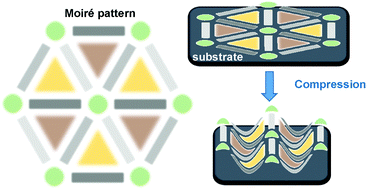Moiré-templated strain patterning in transition-metal dichalcogenides and application in twisted bilayer MoS2†
Abstract
To take full advantage of the electronic properties of transition-metal dichalcogenides and their vdW layered structures, it will be necessary to control the local electronic structure, on which the effect of lattice deformation is significant. Nevertheless, a general approach to programming nanoscale morphology in TMD materials, which would permit local strain engineering, has proven elusive. In this work, we propose a general moiré-templated nanoscale morphology engineering method based on bilayer TMDs. The moiré superlattice plays the key role in enforcing in-plane periodical variations in local interlayer spacing and potential energy. Upon global in-plane compression, the high-energy, large-interlayer-separation stacking domains serve as periodic buckling initiation sites. The buckled features can be thus precisely correlated to the moiré periodicity. The spatial profile of the buckled morphology and strain field are possible to be pre-determined, providing a bridge to the electronics and optoelectronics design. We take twisted bilayer MoS2 to demonstrate our approach. We further demonstrate how the morphology can modulate band gap and optical absorption of a MoS2 monolayer, envisioned as a potential constituent layer in a Moiré-templated, strain-engineered vdW heterostructure of TMDs. The robustness and programmable nature of our approach arise from superlattice symmetry, energetics and mechanics. Our approach provides a new strategy for on-demand design of morphology and local strain in TMDs under mechanical deformation.



 Please wait while we load your content...
Please wait while we load your content...
